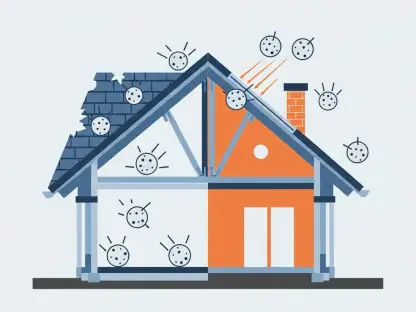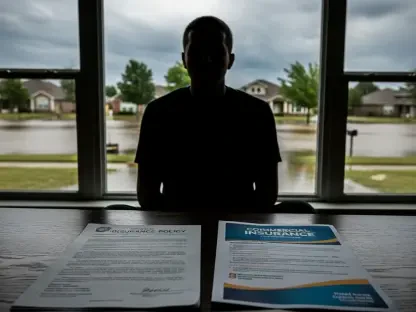Diving into the complex world of property insurance and mortgage costs, we’re thrilled to sit down with Simon Glairy, a renowned expert in insurance and Insurtech, with a deep focus on risk management and AI-driven risk assessment. With years of experience analyzing trends that impact homeowners and the housing market, Simon offers unparalleled insights into the escalating costs of property insurance and their ripple effects on mortgage payments. In this conversation, we explore the driving forces behind rising insurance premiums, the challenges homeowners face, regional disparities, the influence of natural disasters, and evolving trends in mortgage delinquency and home equity. Join us as we unpack these critical issues shaping the financial landscape for millions of Americans.
Can you walk us through why property insurance costs are becoming such a significant chunk of the average mortgage payment?
Absolutely. Property insurance costs have surged in recent years due to a combination of factors. We’re seeing premiums climb as insurers adjust to higher risks and costs associated with claims. This is now almost 10% of the monthly mortgage payment for many homeowners, which is a historic high. It’s not just a small line item anymore; it’s a substantial burden that’s growing faster than other components like principal or interest. The requirement by major players in the mortgage market to carry replacement cost value policies, rather than cheaper alternatives, also plays a big role. These policies ensure full rebuilding costs are covered, which drives up premiums significantly, especially in high-risk or high-value areas.
What specific factors are pushing these property insurance costs higher?
There are several key drivers. First, the increasing frequency and severity of natural disasters like wildfires and hurricanes have led insurers to reassess risk in many regions, resulting in higher premiums. Second, rising home values—up $20 trillion since 2020 across the U.S.—mean that the cost to replace or repair a home has skyrocketed, and insurance policies must reflect that. Additionally, inflation in construction materials and labor costs further inflates the price of coverage. And let’s not forget regulatory and market dynamics; insurers are pulling back in some high-risk states or raising rates to cover their own financial exposure after major loss events.
How are these rising insurance costs impacting homeowners, particularly their ability to manage mortgage payments?
The impact is profound, especially for those on tighter budgets. When insurance costs eat up nearly 10% of a monthly mortgage payment, it squeezes disposable income, making it harder to keep up with other expenses or save for emergencies. For many, this creates a real risk of financial distress. If these costs continue to outpace income growth, we could see more homeowners struggling to stay current on their mortgages. It’s a domino effect—higher insurance costs lead to stress on monthly budgets, which can push some toward delinquency if they can’t find a way to offset the expense.
Are there certain groups of homeowners who are feeling this pinch more than others?
Definitely. Younger homeowners, particularly millennials and Gen Z, are often hit hardest. Many of them are first-time buyers who may have stretched their finances to get into the market, and they’re less likely to have the financial cushion that older generations, like Gen X or baby boomers, might have built up. Studies show that nearly a third of these younger homeowners are struggling with their monthly payments, and insurance costs are a big part of that. They’re also more likely to be in markets with rapidly rising home values, which compounds the insurance premium increases.
Can you break down how the share of property insurance in mortgage payments compares to other components like principal or interest?
Sure. Right now, property insurance accounts for about 9.6% of the average monthly mortgage payment, which is the highest share on record. Over the past five and a half years, insurance costs have jumped nearly 70%, far outpacing other parts of the payment. For comparison, principal payments have risen about 23%, interest about 27%, and property taxes also around 27% over the same period. So, while all components are increasing, insurance is the fastest-growing piece of the puzzle, consuming almost one in every ten dollars spent on mortgage-related costs.
Why do you think insurance costs are climbing so much faster than these other mortgage components?
It comes down to the unique risks and market dynamics tied to insurance. Unlike principal or interest, which are more directly tied to loan terms and market rates, insurance is heavily influenced by external factors like natural disasters and replacement costs. When a region faces a major event—say, a wildfire season or a hurricane—insurers often spread the cost of claims across a wider pool of policyholders through higher premiums. Plus, as home values soar, the insured amount must rise, and that’s a direct hit to premiums. Property taxes and interest rates don’t adjust as dynamically to these kinds of shocks, which is why insurance stands out as the outlier in terms of growth.
Let’s talk about regional differences. What’s driving the sharp increase in property insurance premiums in places like California?
California, and particularly areas like Los Angeles, has seen dramatic spikes—premiums are up 9% in the first half of this year alone and nearly 20% year-over-year. The primary culprit is the heightened risk from wildfires, which have caused significant damage in recent years. These events not only lead to massive claims but also prompt insurers to either raise rates or exit certain markets altogether, reducing competition and driving costs higher. Add to that the state’s high property values, and you’ve got a recipe for steep premium hikes as replacement costs soar.
What’s the situation with property insurance costs in Florida, and why have they started to stabilize?
Florida has long been one of the priciest states for property insurance due to its exposure to hurricanes and flooding. However, we’re seeing a bit of moderation recently. This leveling off is partly due to state-level interventions and reforms aimed at stabilizing the insurance market, such as efforts to reduce fraud and litigation costs that have historically inflated premiums. While costs are still high, the rate of increase has slowed as the market adjusts to these changes and as some insurers cautiously re-enter or expand their presence in the state after pulling back.
How are natural disasters and rising home values influencing these higher insurance premiums?
Natural disasters are a huge factor. Events like wildfires in California or hurricanes along the Gulf Coast result in billions in claims, and insurers respond by raising premiums to cover future risks. These events are becoming more frequent and severe, so the risk models are constantly being adjusted upward. At the same time, home values have surged—nationally, the housing market is worth over $55 trillion now. Higher property values mean higher replacement costs, which directly translate to pricier insurance policies. It’s a double whammy for homeowners in disaster-prone or high-value areas.
Since flood damage often isn’t covered by standard homeowners’ insurance, how does that affect people in flood-prone regions?
It’s a significant gap in coverage that leaves many homeowners vulnerable. Standard policies typically exclude flood damage, so those in flood-prone areas must purchase separate flood insurance, often through federal programs or private insurers. This adds another layer of cost on top of already rising premiums for standard coverage. For those who don’t buy flood insurance—either due to cost or underestimating the risk—a single event can wipe out their savings or equity. It’s a tough spot, especially in places like Florida or coastal areas where flooding is a recurring threat.
Shifting gears a bit, can you explain why mortgage delinquency rates have recently dropped?
Yes, we’ve seen a decline in delinquency rates, down to about 3.27% this year, which is a 9 basis point drop from last year. A big reason is the strong performance of loans originated in 2020 and 2021, when interest rates were historically low. These loans, which make up a large share of active mortgages, are less likely to go delinquent because borrowers locked in affordable payments. Additionally, more borrowers are curing their delinquencies—catching up on missed payments—than are falling behind, which helps bring the overall rate down.
Looking ahead, what’s your outlook for delinquency rates, especially with newer loans?
While the current trend is positive, there’s some concern on the horizon. Newer loans, especially those originated in a higher interest rate environment, are showing slightly higher delinquency rates because borrowers are stretched thinner with larger monthly payments. As these loans become a bigger portion of the market, they could put upward pressure on the national rate. However, the cushion of those low-rate 2020-2021 loans should help temper any sharp increases for now, assuming economic conditions don’t take a major downturn.
Lastly, what’s your forecast for property insurance costs and their impact on the housing market over the next few years?
I expect property insurance costs to continue rising, though perhaps not at the breakneck pace we’ve seen recently. Natural disasters aren’t going away, and climate-related risks will likely keep pushing premiums up, especially in vulnerable regions. Home values are also unlikely to drop significantly, so replacement costs will remain high. For the housing market, this could mean more affordability challenges, particularly for first-time buyers or those in high-risk areas. We might see some innovation from Insurtech—using AI and data analytics to better price risk or offer tailored policies—but it won’t fully offset the upward trend. Homeowners will need to budget carefully, and policymakers may need to step in with solutions to keep insurance accessible and prevent widespread financial distress.









